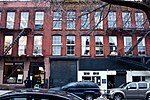BoCoCa
BoCoCa is a portmanteau word combining the names of three adjacent neighborhoods in the Brooklyn borough of New York City: Boerum Hill, Cobble Hill, and Carroll Gardens. BoCoCa is not an actual neighborhood, but an umbrella term for the small region of Brooklyn directly south and southwest of Downtown Brooklyn. The relatively new name is not widely used, but is gaining greater currency, even outside the United States. Among the publications using BoCoCa to classify neighborhoods are the Not for Tourists guide and New York magazine, both of which list BoCoCa together with neighboring Red Hook.NYC & Company, New York City's "official marketing, tourism and partnership organization", has conferred recognition of the term BoCoCa on its web site. However, it is a word that is almost never used by actual residents of the three neighborhoods in question.
Excerpt from the Wikipedia article BoCoCa (License: CC BY-SA 3.0, Authors).BoCoCa
Baltic Street, New York Brooklyn
Geographical coordinates (GPS) Address Nearby Places Show on map
Geographical coordinates (GPS)
| Latitude | Longitude |
|---|---|
| N 40.6857 ° | E -73.9941 ° |
Address
Baltic Street 284
11201 New York, Brooklyn
New York, United States
Open on Google Maps








